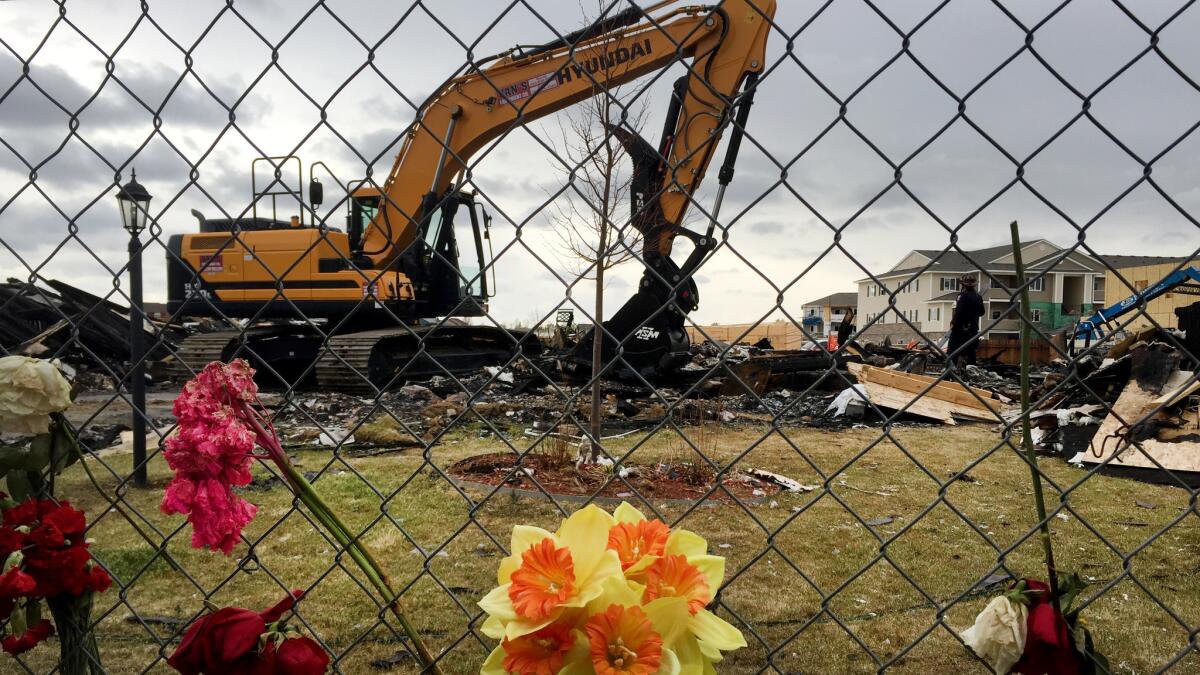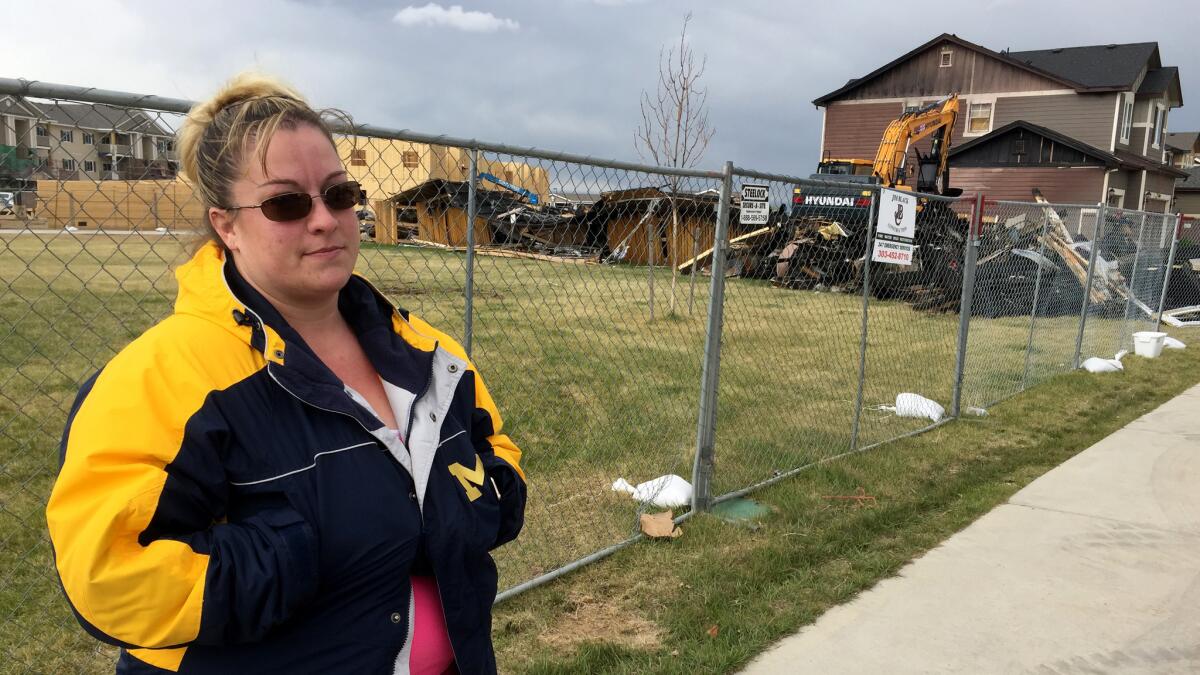Anadarko Petroleum shuts down 3,000 wells in Colorado after a deadly house explosion

- Share via
Reporting from FIRESTONE, Colo. — The Martinez house on Twilight Avenue is obliterated. Charred wood, shattered window frames and insulation are strewn about the ground.
What survives is the concrete basement where Mark Martinez and his brother-in-law Joey Irwin, both 42, were working on a water heater moments before the house exploded in a fireball.
The April 17 accident killed both men. A nearby construction crew crashed their forklift through a fence and lifted part of the house off Martinez’s wife, Erin, who was badly burned but is expected to survive. Their two children escaped unharmed; their two dogs are still missing.
But an investigation into what initially seemed like a tragic household accident is now looking at a natural gas and oil well just 178 feet from the Martinez home along with thousands of similar wells across Weld County and beyond.
On Wednesday, well owner Anadarko Petroleum, the state’s largest oil and gas producer, shut down 3,000 wells throughout northern Colorado, including seven near the blast site.
The company said it was acting out of an “abundance of caution.” The wells will remain closed until inspectors complete a wide range of field tests that could take a month.
“Our teams will remain actively engaged with residents in the Firestone community,” said Brad Holly, Anadarko’s senior vice president for U.S. onshore exploration and production, in a prepared statement. “Colorado residents must feel safe in their own homes, and I want to be clear that we are committed to understanding all that we can about this tragedy as we work with each investigating agency until causes can be determined.”
But the possibility of living near old and potentially leaky gas wells has many in the Oak Meadows subdivision, about 25 miles north of Denver, feeling anything but safe.
“I feel scared. My daughter is deathly afraid to be home now,” said Leah Anderson, 42, who lives near a well. “If they find out there is gas in the soil here we will probably leave. Of course, we could probably never sell the place now.”
Her pilot light went out two days ago, and she’s afraid to light it for fear of an explosion. Others worry about turning on the gas stove or going into the basement.
The well was drilled in 1993 and has changed hands numerous times before Anadarko acquired it in 2014. It primarily produces gas with a little oil. All of the shut wells are older, vertical ones that go straight down from the top, unlike newer horizontal wells that can move in different directions.
“Based on all the investigations to date, the Colorado Oil and Gas Conservation Commission believes there is no immediate threat to the environment or public safety associated with oil and gas operations in the neighborhood,” said commission director Matthew Lepore at a news conference Thursday. The commission regulates oil and gas exploration in Colorado.
He said there were 54,000 active oil and gas wells in the state and about 48,000 are vertical.
Boulder County commissioners responded to the Firestone explosion Thursday by calling for the closing of all vertical wells in their county. Patrick Murphy, an oil and gas specialist with Boulder County Public Health, said there are about 300 wells in the county, nearly all vertical. Of those, 172 are of similar age to the Firestone well.
Anadarko said inspectors are focusing on underground lines associated with each wellhead, especially those near housing and commercial developments. An apartment complex is going up just behind the home that exploded.
Industry expert Mark McDonald of Boston-based NatGas Consulting has spent 25 years investigating gas explosions.
He believes the lines that move gas and oil from wellheads to processing plants are under-regulated. If not properly maintained, he said, corrosion and leaks can occur.
“Hopefully, it will dissipate through the soil into the air, but sometimes it will travel along a previous trench or sideways or underground into someone’s home, and then you have a time bomb,” he said. “Natural gas is odorless. Some companies add odorant so we can smell it, but it’s been my experience that a lot of these companies don’t add odorant. Your nose is your best defense.”
A spokesman for the Oil and Gas Conservation Commission said odorant is usually added by the utility that ships the gas to the house, not by the driller. That means gas leaking from the well would probably be difficult to detect.
McDonald said the presence of oil and gas wells so close to neighborhoods is worrying.
“Everyone is concerned about the health impacts,” he said. “But the real concern is the safety impact.”
The explosion investigation is being led by the Frederick-Firestone Fire Protection District.
“We will continue to gather and analyze evidence to determine the origin and cause of the event,” the fire district said in a statement. “While the well in the vicinity is one aspect of the investigation, this is a complex investigation and the origin and cause of the fire have not been determined.”
Meanwhile, residents wonder what’s next.

Heather Sawlidi, 31, lives a few doors from the accident scene. The day it happened, she said, her floors began to shake violently. Her 7-year-old son ran to her.
“He said, ‘Mom, I promise I didn’t do anything,’” she recalled. “I looked out the window and insulation was blowing up the street.”
She made a video showing orange flames engulfing the house, plumes of black smoke rising into the sky.
Sawlidi is treasurer of the Oak Meadows Homeowners Assn. and is clearly shaken by it all. Her son keeps asking if he’s safe at home.
“That’s my main job as a parent, to keep my children safe, and I can’t answer that question,” she said, standing along a fence surrounding debris from the blast. “I didn’t use the gas for two days after the explosion. I made my husband turn on the stove while I stood by the door.”
She pointed toward another well perhaps 300 yards away and others beyond. Gas wells are ubiquitous in Weld County. They sit near schools, apartments, homes and grocery stores.
“If this is Anadarko’s fault, what are they willing to do about it? They say they are here for us but where are they? No one has spoken to me,” she said.
As she spoke, inspectors tested front yards on Twilight Avenue for evidence of gas in the soil. Motorists cruised past, gawking at the devastation.
“Look at that,” she said. “This isn’t an amusement park, get out of here.”
Sawlidi doesn’t want to move — she has moved seven times in nine years.
“I just want the truth. Don’t lie to me,” she said. “And don’t make me lie to my kids.”
More to Read
Sign up for Essential California
The most important California stories and recommendations in your inbox every morning.
You may occasionally receive promotional content from the Los Angeles Times.










